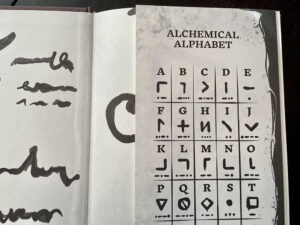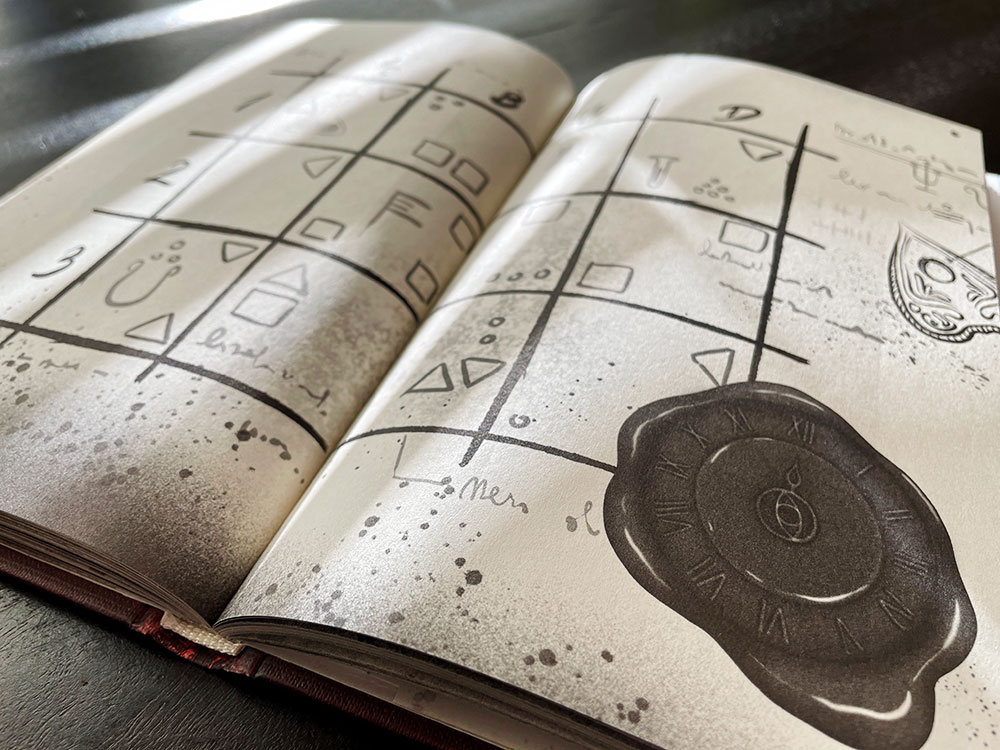 My partner’s in her lab again. I can hear her joyfully exclaim when she discovers, growl when a breakthrough slips through her fingers. She’s been at this for days, alone and working by candlelight, ever since we stumbled upon the final ingredient to the philosopher’s stone. Something seems to call to her, which is most apparent when she emerges (rarely) with a faraway look glittering behind all the grime splattered across her face. I call her name. Her brow furrows, sight lost to thought, and back to the lab she returns.
My partner’s in her lab again. I can hear her joyfully exclaim when she discovers, growl when a breakthrough slips through her fingers. She’s been at this for days, alone and working by candlelight, ever since we stumbled upon the final ingredient to the philosopher’s stone. Something seems to call to her, which is most apparent when she emerges (rarely) with a faraway look glittering behind all the grime splattered across her face. I call her name. Her brow furrows, sight lost to thought, and back to the lab she returns.
I wish we’d never been mysteriously sent The Book of Rituals, published by Board & Dice, and designed by Jakub Caban and Bartosz Idzikowski. It’s a sinister book of puzzles that plays cooperatively from one to four players. There used to be four of us. I think.
Gameplay Overview:
The Book of Rituals is set in the Escape Tales universe of games, though knowledge of this series is not needed to undertake the deduction within. As you flip the front cover, you’re presented with short introduction that leads into Chapter I: Elements. There are three chapters in all, and you must progress through each in order, though the order you complete the puzzles in each section jumps around.

Before diving into the puzzles, it must be noted that the introduction has a QR code that provides access to a web-based application required to answer each puzzle. The application also provides a space for hints to help players progress, as well as video tutorials when the solution is too hard to discover on your own. As such, players don’t have to feel like the book has no path forward when a puzzle becomes daunting. Which will happen.
Chapter I presents the basic elements, which provide their own level of difficulty, before opening to Chapter II and the choose-your-own-adventure pathway of the ingredients. Chapter II: Ingredients has players seeking answers to the philosopher’s stone as well as the circle of life. Once all of these are solved, players can then move on to Chapter III: Rituals. The final chapter puts all puzzle solutions together for thirteen rites that must be solved to finish the book.
To help with these puzzles, an alchemical alphabet is present in the front inner section of the book, while the back inner section features a place to write all answers for each puzzle successfully completed. These two panels can be flipped out for easy access while solving puzzles and rites. Each puzzle along the way also features a key in the top right corner that explains which elements or ingredients are required to help solve it. Sometimes their uses are easy to understand, whereas other times they are much harder to discern.

Game Experience:
That’s about as much of an overview that can be given without spoiling the enjoyment inside. This is more akin to a cooperative adventure than a board game, and it’s easy to see how this book sprung from the mind of an escape-style game designer. It’s best to approach The Book of Rituals as an experience that you can step away from and return to over time so that its nuances do not frustrate.
The design of some puzzles can appear rather opaque, with only certain ingredients listed as hints to what you must seek. With no guiding light, the artwork (from Magdalena Klepacz) lends itself beautifully to the wicked sense of humor that peers out on occasion. This is a design that knows you will be frustrated, so keeping the theme on point lends to the feeling of being an alchemist during the puzzle solving. The book also features many overlapping puzzle designs that are fun to behold.

This book shines when you’ve sat for some time with a puzzle and then suddenly understand what it’s asking you to do. These moments of enlightenment push players further into the depths as they unlock an ingredient that can be used for a puzzle that looks appealing. But not all puzzles are equal, and even after asking the web application to show us a solution, and then watching the tutorial video to understand what we needed to do, we’ve come away from a few of them not entirely satisfied by the design logic.
Those moments are few and far between, though, as the book features forty-five tasks to complete and many are certainly solvable. The book is better with at least one other person, and in fact, it may be best as a duo’s deduction game. Even giving yourself a timer and then working through hints while trying to get closer to a solution provides some direction, though the experience is truly the finest when taken leisurely so that the solutions open over time.

The entirety of the book takes some time to complete. BGG estimates playing time at 240—540 minutes. As of this writing, we’re two ingredients away from starting the final thirteen rituals. We sit down and solve two or three at a time. Put the book away, return for another set. As this is a fully consumable product, there’s no rush because it will all be over eventually. And at that time, we expect to erase everything we’ve scribbled inside and pass the torment on to the next unsuspecting victim. With a smile, of course.
Final Thoughts:
My partner has now asked me for a bottle of alcohol. She’s saying it’s for the Rite of Soul Cleansing, but I’m so far removed from the inner workings of her lab that I have no idea if it’s true. The look in her eyes when I hand her the bottle fills me with dread. She slowly closes the door. Shortly thereafter, I hear the glass of the bottle shatter, but I do not dare open that door.
The Book of Rituals has entered our home and changed it forever. It’s been an illuminating and frustrating experience, but never one that’s stopped me (or my partner) from seeking out answers. Even through its one-and-done nature, it will leave a lasting impression on all who seek to solve it. But for some, they may find themselves consumed by what’s discovered inside. I hope those poor souls can solve the Rite of Soul Cleansing (and all others) and make it back to the other side wholly intact.
Final Score: 3.5 stars – Excellent puzzles with strong thematic connections, a strong sense of exploration, and a constant state of agony.
 Hits:
Hits:
• Strong thematic ties
• Web-based assistance
• Many eureka moments
• Open exploration of puzzles
Misses:
• Several solutions require hints
• Not all hints are helpful
• Difficulty ramps up fast
Source: Board Game Quest





